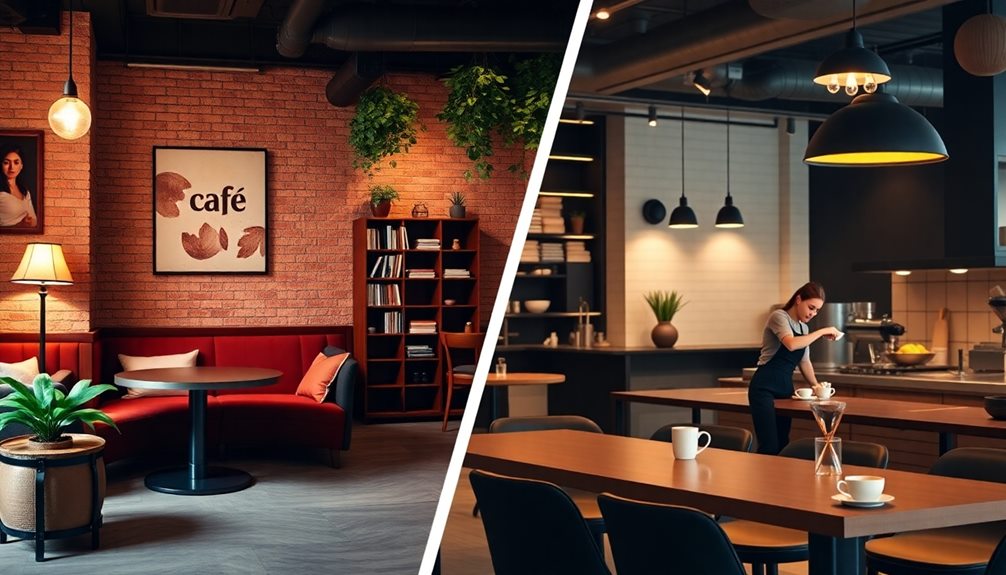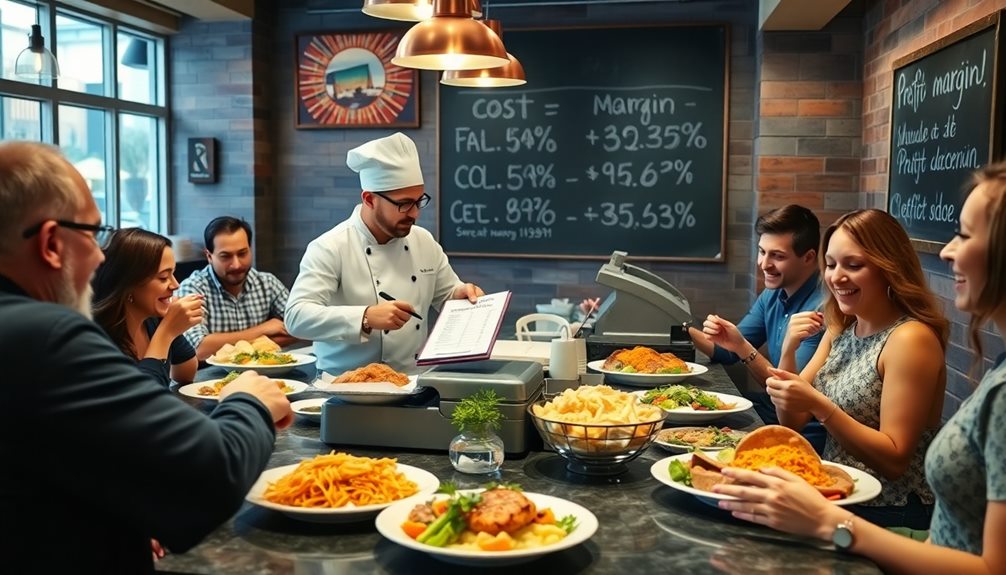A café and a coffee shop both serve coffee, but they have distinct differences. Coffee shops focus on specialty coffee and quick service, offering limited snacks like pastries. In contrast, cafés provide a broader menu that includes meals and desserts, creating a cozy atmosphere for socializing. You'll find coffee shops in busy urban areas, catering to those on the go, while cafés often sit in quieter neighborhoods, encouraging longer visits. If you're curious about how these spaces influence customer experience and menu choices, there's plenty more to explore beyond this!
Key Takeaways
- Coffee shops primarily focus on specialty coffee and espresso drinks, while cafés offer a wider menu including meals and desserts.
- The atmosphere in coffee shops is minimalist and designed for quick visits, whereas cafés promote a cozy environment for social interactions.
- Coffee shops emphasize speed and efficiency in customer experience, while cafés encourage leisurely dining and community engagement.
- Coffee shops are often located in urban areas for high foot traffic, while cafés are typically found in quieter neighborhoods.
- Both establishments prioritize sustainability, but cafés often focus on local sourcing and broader dietary options while coffee shops enhance convenience through technology.
Definitions and Core Concepts

When you walk into a coffee shop, you often find a focus on specialty coffee and espresso drinks, perfect for a quick pick-me-up.
Coffee shops cater primarily to customers looking for high-quality beverages, emphasizing the art of coffee preparation over extensive menu offerings. Their minimalist and functional atmosphere is designed for quick visits, allowing you to grab your drink and go.
In contrast, cafés offer a broader food selection, including meals, sandwiches, salads, and desserts.
The inviting decor fosters a sense of community, encouraging social interaction and longer stays. You'll notice a more relaxed dining experience in cafés, where table service is common, making it a great spot for catching up with friends or enjoying a leisurely meal.
While both coffee shops and cafés serve coffee, the core concept of a coffee shop revolves around the quality of specialty coffee.
The customer experience in coffee shops focuses on efficiency and speed, whereas cafés prioritize comfort and a more extensive food offering, creating a distinct atmosphere that suits different needs and preferences.
Understanding these differences can help you choose the right spot for your next coffee outing.
Menu Offerings

What sets the menu offerings of coffee shops apart from those of cafés? Coffee shops primarily focus on specialty coffee drinks like espressos, lattes, and cold brews. Their food options are usually limited to pastries and light snacks that complement these beverages. You might grab a quick muffin or a croissant, but don't expect a full meal.
On the other hand, cafés provide a much broader menu, catering to diverse culinary preferences. You can enjoy breakfast, lunch, or even dessert items, including sandwiches, salads, and house-made pastries. This extensive range allows cafés to cater to various dietary needs, with many offering vegan and gluten-free selections.
While coffee shops pride themselves on high-quality beverages, they typically create a quick bite experience. In contrast, cafés aim for a full dining experience, encouraging you to linger over your meal.
If you're looking for a leisurely sit-down with a satisfying meal, a café is your best bet. For a quick coffee break, a coffee shop suits you perfectly. Ultimately, your choice depends on whether you're after a light snack or a hearty meal.
Atmosphere and Customer Experience

Choosing between a coffee shop and a café often comes down to the atmosphere and customer experience you're after.
Coffee shops typically exude a modern, minimalist vibe, perfect for quick visits and efficient service. If you're in a hurry, these spots cater to your need for fast coffee and a focused environment.
On the other hand, cafés invite you into a cozy decor that encourages leisurely dining and social interactions.
The seating arrangements at coffee shops often limit you to small tables for individuals or small groups, making them less accommodating for larger gatherings.
In contrast, cafés offer varied seating options that promote a community feel, ideal for families or friends wanting to spend quality time together.
While coffee shops focus on quick turnover, cafés often host events or activities, enhancing the sense of belonging and social engagement.
If you're looking for a place to enjoy a meal and connect with others, a café might be your best bet.
However, if you prefer a fast-paced atmosphere with a singular focus on coffee, a coffee shop is the way to go.
Location and Accessibility

Situated in bustling urban areas, coffee shops capitalize on high foot traffic and proximity to public transport, making them a go-to for commuters who need a quick caffeine fix.
Their strategic location caters to those seeking accessibility and quick service during busy work hours.
In contrast, cafes find their charm in quieter neighborhoods, promoting a relaxed atmosphere where you can linger and socialize.
This difference in location influences the experience you have at each type of establishment.
- Coffee shops focus on convenience and speed, perfect for your on-the-go lifestyle.
- Cafes often nestle near parks or community spaces, inviting you to unwind.
- While coffee shops thrive on customer loyalty from busy professionals, cafes build connections through leisurely dining experiences.
- The inviting spaces of cafes encourage extended visits, making them ideal for catching up with friends.
Ultimately, the location and accessibility of these establishments play pivotal roles in shaping your experience, whether you're grabbing a quick coffee or enjoying a leisurely brunch.
Understanding these differences can help you choose the right spot for your mood and needs.
Sustainability and Technology

Sustainability and technology are becoming essential elements in both cafes and coffee shops as they adapt to modern consumer demands. You'll notice that many coffee shops are embracing eco-friendly practices, like encouraging you to use reusable cups and offering discounts for those who bring their own containers. This not only promotes sustainability but also fosters a community spirit among customers.
Additionally, just as home cinema projectors focus on quality to enhance user experience, cafes and coffee shops are prioritizing high-quality ingredients and sustainable practices to improve overall service. Top 5 Projectors for Gaming Enthusiasts highlight the importance of adaptability, which reflects how these establishments are evolving to meet customer expectations.
Cafes often take sustainability a step further by focusing on local sourcing of ingredients. By supporting nearby farmers, they're reducing their carbon footprint and providing you with fresher options.
On the technology side, coffee shops have integrated mobile apps that enhance customer convenience, allowing you to quickly order and earn rewards through loyalty programs.
Cafes are also leveraging online ordering and delivery services via apps, making it easier for you to enjoy your favorite drinks from the comfort of your home. This shift not only meets your desire for convenience but also allows these establishments to reach a broader customer base.
As cafes and coffee shops continue to intertwine sustainability with technology, you can expect a more environmentally conscious and user-friendly experience.
Frequently Asked Questions
What Is the Difference Between a Cafe and a Caff?
A café offers a wider menu and a cozy atmosphere for socializing, while a caff focuses primarily on quick coffee services with limited food options. You'll enjoy a different experience at each place.
Is CAF Short for CAFe?
Sure, "CAF" sounds like a fancy abbreviation, but it's not officially recognized as shorthand for "café." You might hear it informally, but it really depends on where you are and who you're talking to.
Is Starbucks a Cafe or a Coffee Shop?
Starbucks is primarily a coffee shop, focusing on coffee-based beverages and quick visits. While it offers some food items, its main appeal lies in its variety of drinks and convenient atmosphere for customers on the go.
What Makes a Cafe a Cafe?
Imagine sinking into a cozy nook, surrounded by the aroma of fresh pastries. A café's charm lies in its diverse menu, inviting ambiance, and warm service, making it a perfect spot for leisurely meals and connection. The soft murmur of conversation and the gentle clinking of cups create a soothing background as you peruse the menu. Not only do the flavors captivate your senses, but the thoughtful presentation of the restaurant’s branding adds to the experience—after all, the best fonts for restaurant logos can evoke warmth, sophistication, or playfulness depending on the culinary style. Each detail, from typography to table setting, is carefully crafted to make you feel at ease.
Conclusion
So, whether you're craving a cozy spot to sip a latte or a quick caffeine fix on the go, knowing the difference between a café and a coffee shop helps you choose the right place. Did you know that nearly 60% of Americans visit a coffee shop at least once a week? This shows just how much we love our coffee culture! So next time you're out, take a moment to appreciate the unique vibe of each spot you visit.









